Reichsbank
This article needs additional citations for verification. (January 2008) |
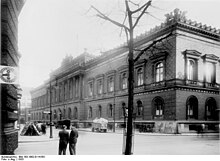 Reichsbank head office at Jägerstraße in Berlin, photographed in 1933 | |
| Headquarters | Berlin |
|---|---|
| Established | 1 January 1876 |
| Ownership | dispersed |
| President | Hermann von Dechend (1876-1890) Richard Koch (1890-1908) Rudolf Havenstein (1908-1923) Hjalmar Schacht (1923-1930, 1933-1939) Hans Luther (1930-1933) Walther Funk (1939-1945) |
| Central bank of | German Empire Weimar Republic Nazi Germany Nazi-occupied territories |
| Currency | German mark (1876-1923) Reichsmark (1923-1945) |
| Preceded by | Bank of Prussia (1876) Oesterreichische Nationalbank (1938) |
| Succeeded by | Banque de France (Elsaß, Lothringen, 1918) Bank deutscher Länder (West Germany) National Bank of Belgium (Luxembourg) |
The Reichsbank (German: [ˈʁaɪçsˌbank] ; lit. 'Bank of the Reich') was the central bank of the German Reich from 1 January 1876 until liquidation in 1945.[1]
Background
The monetary institutions in Germany had been unsuited for its economic development for several decades before unification. In the Kingdom of Prussia, the Bank of Prussia had been established in 1847 and, in the aftermath of the revolution of 1848, five additional banks had been granted a note-issuance privilege (the Berliner Kassenverein, Kölnische Privatbank, Magdeburger Privatbank, Ritterschaftliche Privatbank in Pommern at Stettin, and Städtische Bank in Breslau), but that was still insufficient to sustain adequate monetary conditions.[2]: 156 By 1851, 9 banks in the whole of Germany (not including Austria) were chartered to issue banknotes.[3]: 16 By early 1870, that number had grown to 31 banks in the territories that would become the German Reich the next year, typically private-sector entities (albeit often under specific government oversight) known in German as Notenbanken.[4]: 141 Twelve of these were in Prussia, four in the Kingdom of Saxony, one in the Kingdom of Bavaria, and the other 14 in various duchies, principalities and free cities.
On 27 March 1870, a law was passed that forbade the formation of further Notenbanken in the North German Confederation. Following the promulgation of the German Empire that law was extended to all German lands, with entry into force on 1 January 1872. These Prussian initiatives precipitated action by the Grand Duchy of Baden and Kingdom of Württemberg to create note-issuing banks of their own, respectively the Badische Bank in Mannheim (est. 1870) and the Württembergische Notenbank in Stuttgart (est. 1871), bringing the total number of Notenbanken to 33.[5]: 14
German Empire

The Reichsbank was established by legislation of the Reichstag of 14 March 1875, and assumed its new role on 1 January 1876 when it succeeded the Bank of Prussia. Meanwhile, on 7 October 1875 the Bank of Prussia had acquired all the physical assets of the Hamburger Bank, which did not issue banknotes but was a major monetary anchor in Northern Germany.[7]
The Reichsbank was technically a private-sector company with individual shareholders, albeit not in joint-stock form, and operated from the start under the close control of the Reich government.[5] The bank was managed by a management board (German: Direktorium) reporting to a supervisory board (German: Curatorium). The Curatorium was chaired by the Imperial Chancellor and included four additional members, one appointed by the emperor and the other three by the Bundesrat. The Direktorium was led by the President (German: Reichsbankpräsident) and all its members were appointed for life by the emperor, upon nomination by the Bundesrat. The law specified that the Direktorium must obey the Chancellor's orders at all times.[5]: 42 The shareholders were represented in a central committee (German: Zentralausschuss) of 15 members, which met at least every month under the chairmanship of the Reichsbank's president and could scrutinize the management but not change it or influence policy decision. Three deputies of the Zentralausschuss were allowed to attend all meetings of the Direktorium and to examine the books of the Reichsbank.[5]: 25-28 The initial shareholders included the former shareholders of the Bank of Prussia (except a few who opted for selling their shares) and new subscribers.[5]: 35 The bank was exempted from all income and trade taxes,[5]: 30 but also had to act as the Reich's fiscal agent without compensation.[5]: 293
The Reichsbank operated throughout the Reich's territory through a network of branches, which numbered 206 at its inception in 1876 and expanded to 330 by 1900.[5]: 56 A formal distinction was made between main branches (German: Reichsbankhauptstellen), whose head was appointed directly by the emperor,[5]: 62 and other branches (German: Reichsbankstellen), but that difference of status was insubstantial in practice.[5]: 47 The bank's employees had the status of civil servants of the Reich,[5]: 61 even though they were paid by the Reichsbank.[5]: 65 The Reichsbank also sponsored the establishment of clearing houses which were established in the 1880s and 1890s in Berlin, Frankfurt, Stuttgart, Cologne, Leipzig, Dresden, Hamburg, Breslau, Bremen, and Elberfeld.[5]: 117
15 of the 32 Notenbanken (other than the Bank of Prussia) relinquished issuing their own banknotes shortly after the Reichsbank's creation; four more did so in the 1880s, six in the 1890s, and three in the early 1900s, leaving only the Bayerische Notenbank, Bank of Baden, Bank of Saxony and Württembergische Notenbank as residual note-issuing institutions by 1906.[8]
Until World War I, the Reichsbank produced a very stable currency, fully convertible into gold and thus known as the German gold mark. In 1909, an amendment to the Banking Act of 1875 made the Rischsbank's notes legal tender and redeemable at the rate of 2790 Marks per kilogram of gold.[9]: 13 At the outbreak of World War I, however, the link between the mark and gold was abandoned, resulting in the Papiermark. The expenses of the war caused inflationary pressure and the mark started to decrease in value.[citation needed].
Weimar Republic


The defeat of Imperial Germany in 1918, the economic burden caused by the payment of war reparations to the Allies, and the social unrest in the early years culminated in the German hyperinflation of 1922–23.[citation needed]
Economic reforms, such as the issue of a new provisional currency – the Rentenmark – and the 1924 Dawes Plan, stabilised German monetary development and thus the economic outlook of the Weimar Republic. One of the key reforms caused by the Dawes Plan was the establishment of the Reichsbank as an institution independent of the Reich government. On 30 August 1924, the Reichsbank began issuing the Reichsmark, which served as the German currency until 1948.[citation needed]
Nazi period



The Nazi regime used the Reichsbank as the centerpiece of their policy of directing Germany's resources towards rearmament and military expansion.
On 31 December 1935, the Reichsbank's note issuing privilege became exclusive, bringing an end to the residual central banking roles of the Bank of Baden, Bayerische Notenbank, Bank of Sawony, and Württembergische Notenbank.[9]: 12
A 1937 law re-established the Reich Government's control of the Reichsbank, and in 1939, the Reichsbank was renamed the Deutsche Reichsbank (“Bank of the German Reich”, lit.: “Bank of the German Realm”) and placed under the direct control of Adolf Hitler, with Walther Funk as the last president of the Reichsbank, from 1939 to 1945.[10]
The Reichsbank benefited by the theft of the property of numerous governments invaded by the Germans, especially their gold reserves and much personal property of the Third Reich's many victims, especially the Jews. Personal possessions such as gold wedding rings were confiscated from prisoners, and gold teeth torn from dead bodies, and after cleaning, were deposited in the bank under the false-name Max Heiliger accounts, and melted down as bullion.
Liquidation
The defeat of Nazi Germany in May 1945 resulted in the dissolution of the Reichsbank, along with other Reich ministries and institutions. The explanation of the disappearance of the Reichsbank reserves in 1945 was uncovered by Bill Stanley Moss and Andrew Kennedy, in post-war Germany. In April and May 1945, the remaining reserves of the Reichsbank – gold (730 bars), cash (6 large sacks), and precious stones and metals such as platinum (25 sealed boxes) – were dispatched by Walther Funk to be buried on the Klausenhof Mountain at Einsiedl in Bavaria, where the final German resistance was to be concentrated. Similarly, the Abwehr cash reserves were hidden nearby in Garmisch-Partenkirchen. Shortly after the American forces overran the area, the reserves and money disappeared.[11] Funk would be tried and convicted of war crimes at the Nuremberg trials, not least for receiving money and goods stolen from Jewish and other victims of the Nazi concentration camps. Gold teeth extracted from the mouths of victims were found in 1945 in the vaults of the bank in Berlin.[citation needed]
The Allied occupation authorities (in the West – the United Kingdom, France and the United States; in the East – the Soviet Union) became responsible for German monetary policy in the immediate postwar years. In this role, the Allies continued to issue Reichsmarks (and Allied military marks) as the German banking system was gradually restored. In 1948, the Reichsmark ceased to exist owing to the introduction of the Deutsche Mark in the West and the East German mark in the East. In West Germany, monetary policy was taken over by the Bank deutscher Länder (Bank of the German States) and later by the Deutsche Bundesbank. In East Germany, this role was assumed by the Deutsche Notenbank (later renamed as the Staatsbank der DDR (State Bank of the German Democratic Republic).
Head office
The Bank of Prussia had commissioned a new head office in the late 1860s, which replaced its previous building dating from the late 17th century. The structure designed by architect Friedrich Hitzig was completed in 1876 as the Reichsbank started activity. In 1892-1894, the Reichsbank erected a palatial southward extension on an adjacent lot facing Hausvogteiplatz, designed by its architects Max Hasak and Julius Emmerich. In the early 1930s, the Reichsbank erected a large new facility on the other side of Kurstrasse, designed by its architect Heinrich Wolff. While the main building was heavily damaged during World War II and eventually demolished in 1960, the 1930s extension survives as the Haus am Werderschen Markt, hosting the German Federal Foreign Office after having been the home of the Socialist Unity Party of Germany in the 1960s, 1970s and 1980s.
-
The Reichsbank (upper right) in a display or recent Berlin architecture, late 1880s
-
Extension on Hausvogteiplats, photographed in 1903
-
Banking hall of the Reichsbank, part of the 1890s extension
-
The bank's Hausvogtei front in 1928
-
1930s extension (Haus am Werderschen Markt)
Branches
In Prussia, the Reichsbank kept the branches it inherited from the Bank of Prussia, including buildings it had purchased from others (e.g. the palace erected by David Schindelmeißer in Königsberg, acquired in 1843) and those it had built for itself (e.g. in Bromberg in 1864). Elsewhere, it did not take over the properties of banks whose monetary role it replaced, and erected new branch buildings instead. By the end of the 19th century, it had newly built branches in most of Germany's significant cities. In some cases, these branches were replaced by more modern ones in the interwar period.
The Reichsbank employed a number of specialized architects for branch design, including the prolific Max Hasak and Julius Emmerich from the 1880s to the early 1900s, Havestadt & Contag in the 1890s and early 1900s, Curjel and Moser in the 1900s, Julius Habicht and Hermann Stiller in the 1900s and 1910s, Philipp Nitze in the 1910s and 1920s, and Heinrich Wolff in the 1920s and 1930s.
Due to Germany's territorial losses following World War I, the former Reichsbank branches in what became the Second Polish Republic were taken over by Bank Polski, and the one in the Free City of Danzig became the Bank of Danzig. During World War II, a number of branches were destroyed and not subsequently rebuilt. The one in Munich, whose construction had started in 1938 on the site of the former Herzog-Max-Palais demolished that year, was only completed in 1951.[12] Following the disappearance of the Reichsbank in 1945, a number of its former branches were taken over by its successor entities, namely the Deutsche Bundesbank in West Germany, the Staatsbank der DDR in East Germany, and the National Bank of Poland in Poland; some in East Germany were demolished later on, such as the Chemnitz branch in 1964.[13] Many other branches have been repurposed for other uses over the years, such as the Bucerius Kunst Forum in Hamburg or the Dommuseum Ottonianum in Magdeburg.
The addresses indicated below are the latest ones, which sometimes differ from original addresses due to street renaming and/or renumbering.
-
Aachen branch, Theaterstrasse 17 (arch. Hasak), completed 1889
-
Brandenburg branch, Neustädter Markt 10 (arch. Hasak), completed 1902
-
Cologne branch, Unter Sachsenhausen 1-3 (arch. Hasak), at completion in 1896
-
The same building in 2009, following damage in World War II[15]
-
The same building in 2010
-
Düsseldorf branch, Heinrich-Heine-Allee 8/9 (arch. Emmerich), completed 1894
-
Duisburg branch, Düsseldorfer Strasse 21 (arch. Stiller), completed 1897
-
Elberfeld branch, Bankstrasse 23 (arch. Hasak), completed 1892
-
Werden, Essen branch, Wesselswerth 9, completed 1902[18]
-
Freiburg im Breisgau branch, Leopoldring 9 (arch. Hasak), completed 1902
-
Fulda branch, Rabanusstrasse 12 (arch. Hasak), completed 1902
-
Göttingen branch, Berliner Strasse 5, completed 1909
-
Hildesheim branch, Zingel 34 (arch. Hasak), completed 1897
-
Hörde (Dortmund) branch, Penningskamp 7, completed 1909
-
Karlsruhe branch, Herrenstrasse 30 (arch. Hasak, Havestadt & Contag), completed 1893
-
Kiel branch, Fleethörn 29 (early 20th century photograph)
-
Krefeld branch, Friedrichsplatz 20 (arch. Stiller), completed 1906
-
Königsberg (now Kaliningrad) branch, Grosser Domplatz, erected in the late 18th century, destroyed in World War II[23]
-
Lübeck new branch, Holstentorplatz 2 (arch. Wolff), completed 1936
-
Mainz branch, Kaiserstraße 52 (arch. Hasak, Havestadt & Contag), completed 1892
-
Munich branch, Ludwigstrasse 13 (arch. Wolff, then Carl Sattler), completed 1951 for the Bayerische Landeszentralbank
-
Münster branch, Domplatz 36 (arch. Hasak, Havestadt & Contag), completed 1894
-
Thorn (now Toruń) branch, Plac Mariana Rapackiego (arch. Habicht), completed 1906
-
Trier branch, Kochstrasse 13 (arch. Hasak), completed 1903
Presidents
| No. | Picture | President of Reichsbank | Took office | Left office | Time in office |
|---|---|---|---|---|---|
| 1 | Hermann von Dechend (1814–1890) | 1876 | 1890 | 13–14 years | |
| 2 | Richard Koch (1834–1910) | 1890 | 1908 | 13–14 years | |
| 3 | Rudolf Havenstein (1857–1923) | 1908 | 11 November 1923 | 14–15 years | |
| 4 | Hjalmar Schacht (1877–1970) | 22 December 1923[27] (appointed Currency Commissioner on 12 November 1923)[28] | 6 March 1930 | 6 years | |
| 5 | Hans Luther (1879–1962) | 7 March 1930 | 17 March 1933 | 3 years | |
| (4) | Hjalmar Schacht (1877–1970) | 18 March 1933 | 19 January 1939 | 5 years | |
| 6 | Walther Funk (1890–1960) | 20 January 1939 | 8 May 1945 | 6 years |
See also
References
- ^ Budzinski, Prof Dr Oliver. "Definition: Reichsbank". wirtschaftslexikon.gabler.de (in German). Retrieved 2020-01-06.
- ^ James M. Brophy (1992), "The Political Calculus of Capital: Banking and the Business Class in Prussia, 1848-1856", Central European History (25:2): 149–176
- ^ Timothy W. Guinnane (2001), Delegated Monitors, Large and Small: The Development of Germany's Banking System, 1800-1914 (PDF), New Haven CT: Yale University Economic Growth Center
- ^ Jacob Riesser (1911), The German Great Banks and Their Concentration in connection with The Economic Development of Germany (PDF), Washington DC: National Monetary Commission
- ^ a b c d e f g h i j k l m National Monetary Commission (1910). "The Reichsbank 1876-1900" (PDF). Washington DC: U.S. Senate.
- ^ "German Notes". 2018-01-06. Retrieved 2021-08-31.
- ^ Ulrich Bindseil (September 2019), Early French and German central bank charters and regulations (PDF), Frankfurt: European Central Bank
- ^ Heinz Fengler (1992), Geschichte der deutschen Notenbanken vor Einführung der Mark-Währung, Regenstauf: Gietl Verlag
- ^ a b Federal Reserve Board (March 1945), Army Service Forces Manual M356-5 / Military Government Handbook - Germany - Section 5: Money and Banking, Washington DC: U.S. Army Service Forces
- ^ Shirer, William L. The Rise and Fall of the Third Reich. Greenwich: Fawcett Publications, 1959. 360.
- ^ Moss, W. Stanley, Gold Is Where You Hide It; What Happened to the Reichsbank Treasure?, Andre Deutsch 1959
- ^ Thomas Müller. "Das Herzog-Max-Palais: Ein Abriss zugunsten der "Hauptstadt der Deutschen Kunst". Munich Art To Go.
- ^ "Reichsbank – Hier ist ihr Geld sicher". chemnitz-gestern-heute.de.
- ^ Jacek Kulesza (11 December 2015). "AC Hotel by Marriott powstanie w gmachu dawnego Banku Rzeszy". wyborcza.pl.
- ^ Walter Buschmann and Alexander Kierdorf. "Bankenviertel Köln". Rheinische Industriekultur.
- ^ "Reichsbankgebäude Eisenach". Architektur Bildarchiv.
- ^ Adrian Sajko (13 August 2014). "Bank opuszcza zabytkowy budynek przy 1 Maja. Kupiec pilnie poszukiwany". info.elblag.pl.
- ^ "Ehemalige Reichsbank". Essener Ruhrperlen.
- ^ Gottfried Kiesow (December 2011). "Die Baukunst zwischen den Weltkriegen". Monumente.
- ^ "LZB Landeszentralbank in Hessen, Frankfurt am Main". Jourdain & Müller Steinhauser Architekten.
- ^ "Ehemalige Reichsbank". duisburg.de.
- ^ "150 lat Katowic. Kocur dostał dwa lwy i wypalił fajkę pokoju". wyborcza.pl. 1 August 2015.
- ^ "Königsberg (Pr.), Großer Domplatz, Reichsbank (Schindelmeißer-Haus)". Ostpreussen Bildarchiv.
- ^ "Reichsbank-Gebäude Lübeck". Architektur Bildarchiv.
- ^ "Die Reichsbank am Breiten Weg". Ottostadt Magdeburg.
- ^ Iris Cramer and Sabine Muschler. "Architektur und Kunst: Deutsche Bundesbank Hauptverwaltung in Baden-Württemberg" (PDF). Deutsche Bundesbank.
- ^ Marsh, David (1992). The Most Powerful Bank: Inside Germany's Bundesbank. New York: Times Books. p. 85. ISBN 0-8129-2158-5.
- ^ Marsh, David (1992). The Most Powerful Bank: Inside Germany's Bundesbank. New York: Times Books. p. 84. ISBN 0-8129-2158-5.
External links
 Media related to Reichsbank at Wikimedia Commons
Media related to Reichsbank at Wikimedia Commons- Documents and clippings about Reichsbank in the 20th Century Press Archives of the ZBW


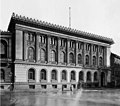
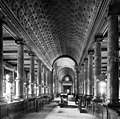




![Breslau (now Wrocław) branch, 10 Wolności Square, completed 1890[14]](http://upload.wikimedia.org/wikipedia/commons/thumb/a/ac/Former_Reichsbank_building_Wroclaw.png/120px-Former_Reichsbank_building_Wroclaw.png)
![Bromberg (now Bydgoszcz) branch, Jagiellońska street 8 (arch. Hermann Cuno [de]), completed 1864](http://upload.wikimedia.org/wikipedia/commons/thumb/d/db/Bdg_ulJagiellonska_4_10-2013.jpg/120px-Bdg_ulJagiellonska_4_10-2013.jpg)

![The same building in 2009, following damage in World War II[15]](http://upload.wikimedia.org/wikipedia/commons/thumb/c/c5/Deutsche_Bank_K%C3%B6ln_-_ehemals_Reichsbank_%283932-34%29.jpg/120px-Deutsche_Bank_K%C3%B6ln_-_ehemals_Reichsbank_%283932-34%29.jpg)
![Danzig (now Gdańsk) branch [de], Karrenwall 10 (arch. Hasak), completed ca. 1904](http://upload.wikimedia.org/wikipedia/commons/thumb/e/eb/Bank_of_Danzig.JPG/85px-Bank_of_Danzig.JPG)

![Darmstadt branch [de], Kasinostraße 5 (arch. Curjel and Moser), completed 1904](http://upload.wikimedia.org/wikipedia/commons/thumb/d/dc/Darmstadt-Ehem-Reichsbank.jpg/120px-Darmstadt-Ehem-Reichsbank.jpg)
![Düsseldorf branch [de], Heinrich-Heine-Allee 8/9 (arch. Emmerich), completed 1894](http://upload.wikimedia.org/wikipedia/commons/thumb/6/60/Ehemaliges_Reichsbankgeb%C3%A4ude%2C_Fassade%2C_Heinrich-Heine-Allee_8-9%2C_D%C3%BCsseldorf-Altstadt.jpg/120px-Ehemaliges_Reichsbankgeb%C3%A4ude%2C_Fassade%2C_Heinrich-Heine-Allee_8-9%2C_D%C3%BCsseldorf-Altstadt.jpg)
![Dresden branch [de], St. Petersburger Strasse 2 (arch. Wolff), completed 1930](http://upload.wikimedia.org/wikipedia/commons/thumb/2/23/Ehemalige_Reichsbank_Dresden_01.jpg/120px-Ehemalige_Reichsbank_Dresden_01.jpg)
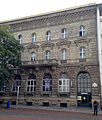

![Eisenach branch [de], Karl-Marx-Straße 53, completed 1905[16]](http://upload.wikimedia.org/wikipedia/commons/thumb/b/be/ESA_Karl-Marx-Str_53_Bild1.jpg/120px-ESA_Karl-Marx-Str_53_Bild1.jpg)
![Elbing (now Elbląg) branch, ulica 1 Maja 16 (arch. Habicht), completed 1910[17]](http://upload.wikimedia.org/wikipedia/commons/thumb/7/7e/Budynek_Banku_przy_ul._1_Maja_nr_16.JPG/120px-Budynek_Banku_przy_ul._1_Maja_nr_16.JPG)
![Werden, Essen branch, Wesselswerth 9, completed 1902[18]](http://upload.wikimedia.org/wikipedia/commons/thumb/6/66/Essen_Werden_-_Wesselswerth-Rittergasse_02_ies.jpg/120px-Essen_Werden_-_Wesselswerth-Rittergasse_02_ies.jpg)
![Frankfurt branch, Taunusanlage 4-6 (arch. Amsler & Wolff), completed 1933,[19] renovated in the 1980s[20]](http://upload.wikimedia.org/wikipedia/commons/thumb/a/a9/Frankfurt_Taunusanlage_4.20130401.jpg/120px-Frankfurt_Taunusanlage_4.20130401.jpg)


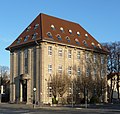
![Hamborn (Duisburg) branch, Duisburger Straße 216, completed 1908[21]](http://upload.wikimedia.org/wikipedia/commons/thumb/8/88/Duisburger_Stra%C3%9Fe_216_Duisburg_Hamborn.jpg/80px-Duisburger_Stra%C3%9Fe_216_Duisburg_Hamborn.jpg)

![Hanover branch [de], Georgsplatz 5 (arch. Hasak, Havestadt & Contag), completed 1896](http://upload.wikimedia.org/wikipedia/commons/thumb/1/18/Deutsche_Bundesbank_office_building_Georgsplatz_5_Hannover_Germany.jpg/120px-Deutsche_Bundesbank_office_building_Georgsplatz_5_Hannover_Germany.jpg)



![Kattowitz (now Katowice) branch, Bankowa 5 (arch. Habicht), completed 1911[22]](http://upload.wikimedia.org/wikipedia/commons/thumb/6/65/Katowice_Bankowa_5_facade_2022.jpg/120px-Katowice_Bankowa_5_facade_2022.jpg)


![Königsberg (now Kaliningrad) branch, Grosser Domplatz, erected in the late 18th century, destroyed in World War II[23]](http://upload.wikimedia.org/wikipedia/commons/thumb/f/f5/Reichsbank_%28K%C3%B6nigsberg%29.JPG/120px-Reichsbank_%28K%C3%B6nigsberg%29.JPG)
![Leipzig branch [de], Petersstrasse 43 (arch. Hasak), completed 1887](http://upload.wikimedia.org/wikipedia/commons/thumb/c/cc/Musikschule_Johann_Sebastian_Bach_Leipzig_2010_cropped.jpg/120px-Musikschule_Johann_Sebastian_Bach_Leipzig_2010_cropped.jpg)
![Lübeck branch, Königsstrasse 45 (arch. Hasak), completed 1895[24]](http://upload.wikimedia.org/wikipedia/commons/thumb/2/2a/Koenigstrasse45.JPG/120px-Koenigstrasse45.JPG)
![Lübeck new branch [de], Holstentorplatz 2 (arch. Wolff), completed 1936](http://upload.wikimedia.org/wikipedia/commons/thumb/3/3f/HL_Bundesbank_4_2013_5.JPG/120px-HL_Bundesbank_4_2013_5.JPG)
![Magdeburg branch [de], Domplatz 15 (arch. Nitze), completed 1923[25]](http://upload.wikimedia.org/wikipedia/commons/thumb/c/ca/Magdeburg_asv2022-08_img19_Dommuseum.jpg/120px-Magdeburg_asv2022-08_img19_Dommuseum.jpg)

![Metz branch [fr], 10-12 avenue Foch (arch. Curjel et Moser), completed 1907](http://upload.wikimedia.org/wikipedia/commons/thumb/9/98/Chambre_Commerce_Industrie_Moselle_-_Metz_%28FR57%29_-_2022-02-26_-_2.jpg/120px-Chambre_Commerce_Industrie_Moselle_-_Metz_%28FR57%29_-_2022-02-26_-_2.jpg)


![Siegen branch [de], Spandauer Straße 40 (arch. Habicht), completed 1911](http://upload.wikimedia.org/wikipedia/commons/thumb/0/0c/Siegen_Reichsbank.jpg/120px-Siegen_Reichsbank.jpg)
![Stuttgart branch, Marstallstrasse 3 (arch. Hans Herkommer [de] & Theodor Bulling), completed 1923[26]](http://upload.wikimedia.org/wikipedia/commons/thumb/3/36/Hauptverwaltung_Deutsche_Bundesbank_Stuttgart_01.jpg/120px-Hauptverwaltung_Deutsche_Bundesbank_Stuttgart_01.jpg)



![Richard Koch [de]](http://upload.wikimedia.org/wikipedia/commons/thumb/5/5f/Richard_Koch_%28Reichsbank%2C_Reclam_Universum%29.jpg/100px-Richard_Koch_%28Reichsbank%2C_Reclam_Universum%29.jpg)



